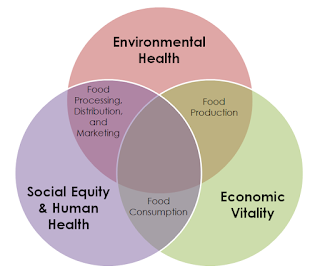In conjunction with my previous blog entry of "Food and Urbanism". I came across this interesting image over the internet, that is placed outside a buffet restaurant.
It is to remind consumers not to take the luxury of food for granted whereby some are struggling to make ends meet in their daily lives.
So, what if the lack of understanding between food and urbanism continues to sink into the deep ends of our mind due to the pluralistic culture of urbanisation and convenience fast food ?"
 |
It is to remind consumers not to take the luxury of food for granted whereby some are struggling to make ends meet in their daily lives.
So, what if the lack of understanding between food and urbanism continues to sink into the deep ends of our mind due to the pluralistic culture of urbanisation and convenience fast food ?"
By 2050, food population is going to be 60% urban and food access is going to be a primary issue. Therefore, in fact not only food production has to be doubled in order to meet global demand of 6.3 billion, food security would also emerge as a major global issue due to limited resources, climate change, economic and demographic lifestyle.
What is food security ?
" It is a complex sustainable development issue that is linked to health through malnutrition but also to sustainable economic development, environment and trade." (World Health Organisation, n.d)
 |
| The relationship between the urban food production & food security towards a sustainable urban development of a city. (Source: http://www.foodsecuritynews.com/images/Food_System_Diagram.png) |
Food security exists "when all people at all times have access to sufficient, safe, nutritious food to maintain a healthy and active life." It is defined by World Health Organisation (WHO) as the both physical and economic access to food that meets people's dietary needs.
 |
| Global Food Security Levels in terms of Food Prices (Source: http://www.desdemonadespair.net/2011/09/graph-of-day-global-food-security.html) |
In Australia, food prices are inevitably controlled by the limited land and water resources. A research was done by the Department of Immigration and Citizenship reveals that by 2050, 430 000 hectares of agricultural land surrounding Melbourne and Sydney will be taken up by housing. With limited resource, a paradigm shift in demand and supply within the chain would lead to an increase in price in order to accommodate the market. Therefore, in this journal, I would take the opportunity in looking to what are the initiatives and preventive measures were taken by designers and their architectural role in combating food security issue.
source : https://www.facebook.com/thingsplus111/videos/1006942379391649/
Starting from an individual level, the start innovation modular system addresses and initiative towards individuals to contribute towards sustainable food development. Not only it eliminate the need for backyard, it also incoporates technological advancement to help care takers throughout the process. Personally, I think this is a valid innovative idea at an individual scale to help in everyway possible towards creating more greenaries within an urban context as well as sustainable food production.
 |
| Source : http://www.archdaily.com/245870/globehedron-rooftop-farm-conceptual-devices |
Next, across the spectrum. the Hedron Rooftop Farm would be the oldest method in combating limited land and water resource in traditional agriculture. Through community participation, it is a bamboo greenhouse designed to organically grow fish and vegetable through aquaponics on top of a generic flat roof in the urban city. In fact, a single structure alone is able to feed 4 families of 4 all year by producing 400kg of vegetables and 100kg of fish.
 |
| Source : http://www.archdaily.com/783314/floating-fields-wins-shenzhen-uabb-award-and-is-set-to-continue-through-2016 |
Subsequently, through an architectural intervention, "The Floating Fields" in Shenzhen is a retrofitted landscape installation from a former factory with the concept of "to return agriculture to the bay with floating agricultural fields" With a series of connected ponds that holds various kinds of aquatic function, it forms a complete ecological system to produce food. The installation not only educates the community about aquaponics through participation, food generated by the system was used to organise events.
Despite these innovations into our fabric of urban farming, others have argued that the exponential growth in human population would still outgrow the food produced through these minor innovations without execution by the community as shwon by the video of modular planning system that is hassel free. However, I personally believe that by allowing communities to become more self-sufficient and operate locally rather than relying on international imports and rural farming is a keystone towards a new age of urbanisation in order to meet food demands of the population.
Resources :
http://www.who.int/trade/glossary/story028/en/
http://www.archdaily.com/783314/floating-fields-wins-shenzhen-uabb-award-and-is-set-to-continue-through-2016
http://www.archdaily.com/245870/globehedron-rooftop-farm-conceptual-devices










